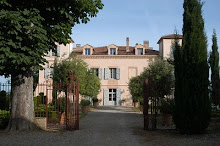Apologies to any of you who've come to my blog only to find that I haven't posted in almost a year. So, I'll just start with the recent past: In late June 2012, I attended the final ever PMC conference near Cincinnati. I say the final conference, because the PMC guild is folding, much to the dismay of all of us who've relied on its information and biennial conferences that provided useful information and the opportunity for bonding with other PMC enthusiasts. Fortunately, Rio Grande is taking over the guild's Website and fund of information. Already, there are agitators pushing for a new organization. Kudos to you!
In my own world of working with PMC and sheet metal, I sometimes finish what looked like a good design in the formative stages and see at the end of the process that I've birthed an ugly baby. I've learned that there is challenge and opportunity in my ugly baby: the challenge of figuring out the mechanics of making changes and the opportunity to make a better piece. Sometimes a piece sits around for quite a while before the lights go on and I realize what my piece needs in order to be finished.
The first piece below I made in a Celie Fago workshop on combining polymer clay with PMC. The resulting piece met all the qualifications but to my eye didn't look quite right. Celie gave us templates and direction for working on the pieces, so they all turned out similarly. Mine, however, didn't nearly approximate the beauty of Celie's original, and honestly, I didn't want to make a copy of Celie's work. I needed to own the piece as mine - my design. So I took out the polymer clay insert and was left with a hole that needed filling.


The piece went through five iterations but unfortunately, I didn't photograph the middle two. My first attempt, which you can see below the original, was to attach a copper disk with a fine silver design screwed on top. I didn't like it. Something about the hangy down thingy of PMC and copper just wasn't doing it for me. I got rid of that during another attempt to fill the void left by the polymer clay by loading it with tiny labradorite beads and then making a shadowbox (done by adding a lid with a center hole). The only way to affix the beads was to use cyanoacrylate and the result looked blobby, like gooey caviar, so I burned out the adhesive (outdoors and using a mask to filter the fumes) and of course ruined the gemstones.
So, once again, I'm looking at a hole inside the lovely PMC "drum." I think for days about how to fill it. I decide, finally, to use pieces of a sea urchin shell that I'd saved for years. I needed to figure out how to hang the pendant, since the original was hung from a sterling wire that went up through the polymer. I decide on a simple bail and solder the bail I'd fashioned onto the PMC. I patina some copper and cut out a donut, then solder it to the PMC back (not easy since the copper requires a higher temperature for soldering). My little butane torch just can't do the job: the top comes off, hanging by tiny solder thread. So I affix it with cyanoacrylate adhesive. Then I slip the sea urchin shell inside with some additional adhesive. The last iteration has the organic look I was going for. Here it is below the first two iterations. I learned something through each stage of this pendant's transformation, so the time and effort was worth it.

Do you prefer one of the earlier iterations of the piece? If so, why? Or do you agree with me that the last transformation is the best? (The last photo is the back of the piece.)
















